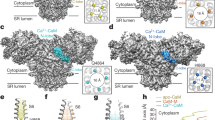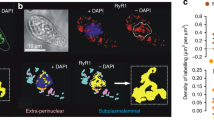Abstract
Calcium release from the endoplasmic reticulum controls a number of cellular processes, including proliferation and contraction of smooth muscle and other cells1,2. Calcium release from inositol 1,4,5-trisphosphate (IP3)-sensitive stores is negatively regulated by binding of calmodulin to the IP3 receptor (IP3R)3,4 and the NO/cGMP/cGMP kinase I (cGKI) signalling pathway5,6. Activation of cGKI decreases IP3-stimulated elevations in intracellular calcium7, induces smooth muscle relaxation8 and contributes to the antiproliferative9 and pro-apoptotic effects of NO/cGMP10. Here we show that, in microsomal smooth muscle membranes, cGKIβ phosphorylated the IP3R and cGKIβ, and a protein of relative molecular mass 125,000 which we now identify as the IP3R-associated cGMP kinase substrate (IRAG). These proteins were co-immunoprecipitated by antibodies directed against cGKI, IP3R or IRAG. IRAG was found in many tissues including aorta, trachea and uterus, and was localized perinuclearly after heterologous expression in COS-7 cells. Bradykinin-stimulated calcium release was not affected by the expression of either IRAG or cGKIβ, which we tested in the absence and presence of cGMP. However, calcium release was inhibited after co-expression of IRAG and cGKIβ in the presence of cGMP. These results identify IRAG as an essential NO/cGKI-dependent regulator of IP3-induced calcium release.
This is a preview of subscription content, access via your institution
Access options
Subscribe to this journal
Receive 51 print issues and online access
$199.00 per year
only $3.90 per issue
Buy this article
- Purchase on Springer Link
- Instant access to full article PDF
Prices may be subject to local taxes which are calculated during checkout





Similar content being viewed by others
References
Berridge, M. J., Bootman, M. D. & Lipp, P. Calcium—a life and death signal. Nature 395, 645–648 ( 1998).
Somlyo, A. P. & Somlyo, A. V. Signal transduction and regulation in smooth muscle. Nature 372, 231– 236 (1994).
Missiaen, L. et al. The bell-shaped Ca2+ dependence of the inositol 1,4,5-trisphosphate-induced Ca2+ release is modulated by Ca2+/calmodulin. J. Biol. Chem. 274, 13748–13751 (1999).
Michikawea, T. et al. Calmodulin mediates calcium-dependent inactivation of the cerebellar type I inositol 1,4,5-trisphosphate receptor. Neuron 23, 799–808 ( 1999).
Eigenthaler, M., Lohmann, S. M., Walter, U. & Pilz, R. B. Signal transduction by cGMP-dependent protein kinases and their emerging roles in the regulation of cell adhesion and gene expression. Rev. Physiol. Biochem. Pharmacol. 135, 173–209 (1999).
Pfeifer, A. et al. Structure and function of cGMP-dependent protein kinases. Rev. Physiol. Biochem. Pharmacol. 135, 105–149 (1999).
Ruth, P. et al. Transfected cGMP-dependent protein kinase suppresses calcium transients by inhibition of inositol 1,4,5-triphosphate production. Proc. Natl Acad. Sci. USA 90, 2623–2627 (1993).
Pfeifer, A. et al. Defective smooth muscle regulation in cGMP kinase I-deficient mice. EMBO J. 17, 3045– 3051 (1998).
von der Leyen, H. et al. Gene therapy inhibiting neointimal vascular lesion: In vivo transfer of endothelial cell nitric oxide synthase gene. Proc. Natl Acad. Sci. USA 92, 1137–1141 (1994).
Chiche, J. D. et al. Adenovirus-mediated gene transfer of cGMP-dependent protein kinase increases the sensitivity of cultured vascular smooth muscle cells to the antiproliferative and pro-apoptotic effects of nitric oxide/cGMP. J. Biol. Chem. 273, 34263–34267 (1998).
Casnelli, J. E. & Greengard, P. Guanosine 3′:5′-cyclic monophosphate-dependent phosphorylation of endogenous substrate proteins in membranes of mammalian smooth muscle. Proc. Natl Acad. Sci. USA 71, 1891–1895 ( 1974).
Koga, T., Yoshida, Y., Cai, J. Q., Islam, M. O. & Imai, S. Purification and characterization of 240-kDa cGMP-dependent protein kinase substrate of vascular smooth muscle. Close resemblance to inositol 1,4,5-trisphosphate receptor. J. Biol. Chem. 269, 11640–11647 (1994).
Komalavilas, P. & Lincoln, T. M. Phosphorylation of the inositol 1,4,5-trisphosphate receptor by cyclic GMP-dependent protein kinase. J. Biol. Chem. 269, 8701– 8707 (1994).
Haug, L. S., Jensen, V., Hvalby, O., Walaas, S. I. & Ostvold, A. C. Phosphorylation of the inositol 1,4,5-trisphosphate receptor by cyclic nucleotide-dependent kinases in vitro and in rat cerebellar slices in situ. J. Biol. Chem. 274, 7467–7473 (1999).
Rooney, T. A., Joseph, S. K., Queen, C. & Thomas, A. P. Cyclic GMP induces oscillatory calcium signals in rat hepatocytes. J. Biol. Chem. 271, 19817–19825 ( 1996).
Tertyshnikova, S., Yan, X. & Fein, A. cGMP inhibits IP3-induced Ca2+ release in intact rat megakaryocytes via cGMP- and cAMP-dependent protein kinases. J. Physiol. (Lond.) 512, 89–96 (1998).
Baltensperger, K., Carafoli, E. & Chiesi, M. The Ca2+-pumping ATPase and the major substrates of the cGMP-dependent protein kinase in smooth muscle sarcolemma are distinct entities. Eur. J. Biochem. 172, 7–16 (1988).
Fujita, S. et al. Characterization of major phosphoproteins in the cGMP-mediated protein phosphorylation system of vascular smooth muscle membranes. J. Vasc. Res. 36, 299–310 (1999).
Surks, H. K. et al. Regulation of myosin phosphatase by a specific interaction with cGMP-dependent protein kinase Iα. Science 286, 1583–1587 (1999).
Behrens, T. W. et al. Jaw1, a lymphoid-restricted membrane protein localized to the endoplasmic reticulum. J. Immunol. 153, 682–690 (1994).
Brenman, J. E., Xia, H., Chao, D. S., Black, S. M. & Bredt, D. S. Regulation of neuronal nitric oxide synthase through alternative transcripts. Dev. Neurosci. 19, 224–231 (1997).
Newton, C. L., Mignery, G. A. & Südhof, T. C. Co-expression in vertebrate tissues and cell lines of multiple inositol 1,4,5-trisphosphate (InsP3) receptors with distinct affinities for InsP3. J. Biol. Chem. 269, 28613– 28619 (1994).
Lipp, P., Thomas, D., Berridge, M. J. & Bootman, M. D. Nuclear calcium signalling by individual cytoplasmic calcium puffs. EMBO J. 16, 7166–7173 ( 1997).
Keilbach, A., Ruth, P. & Hofmann, F. Detection of cGMP-dependent protein kinase isozymes by specific antibodies. Eur. J. Biochem. 208, 467–473 (1992).
Nguyen, T., Chin, W.-C. & Verdugo, P. Role of Ca2+/K+ ion exchange in intracellular storage and release of Ca2+. Nature 395, 908–912 ( 1998).
O'Rourke, F. et al. Ca2+ release by inositol 1,4,5-trisphosphate is blocked by the K+-channel blockers apamin and tetrapentylammonium ion, and a monoclonal antibody to a 63 kDa membrane protein: reversal of blockade by K+ ionophores nigericin and valinomycin and purification of the 63 kDa antibody-binding protein. Biochem. J. 300, 673–683 ( 1994).
Shaughnessy, J. D. Jr et al. Mrvi1, a common MRV integration site in BXH2 myeloid leukemias, encodes a protein with homology to a lymphoid-restricted membrane protein Jaw1. Oncogene 18, 2069 –2084 (1999).
Wilm, M., Neubauer, G. & Mann, M. Parent ion scans of unseparated peptide mixtures. Anal. Chem. 68, 527–533 (1996).
Broad, L. M., Armstrong, D. L. & Putney, J. W. Jr Role of inositol 1,4,5-trisphosphate receptor in Ca2+ feedback inhibition of calcium release-activated calcium current (I crac). J. Biol. Chem. 274, 32881–32888 ( 1999).
Acknowledgements
We thank S. Kamm and C. Wolf for technical assistance. This work was supported by Deutsche Forschungsgemeinschaft and Fond der Chemischen Industrie.
Author information
Authors and Affiliations
Corresponding author
Rights and permissions
About this article
Cite this article
Schlossmann, J., Ammendola, A., Ashman, K. et al. Regulation of intracellular calcium by a signalling complex of IRAG, IP3 receptor and cGMP kinase Iβ. Nature 404, 197–201 (2000). https://doi.org/10.1038/35004606
Received:
Accepted:
Issue Date:
DOI: https://doi.org/10.1038/35004606
This article is cited by
-
Phosphodiesterase 5 inhibitor mirodenafil ameliorates Alzheimer-like pathology and symptoms by multimodal actions
Alzheimer's Research & Therapy (2022)
-
Jaw1/LRMP increases Ca2+ influx upon GPCR stimulation with heterogeneous effect on the activity of each ITPR subtype
Scientific Reports (2022)
-
RNA-sequencing of human aortic valves identifies that miR-629-3p and TAGLN miRNA-mRNA pair involving in calcified aortic valve disease
Journal of Physiology and Biochemistry (2022)
-
Paracrine FGFs target skeletal muscle to exert potent anti-hyperglycemic effects
Nature Communications (2021)
-
Genetic variants of cGMP-dependent protein kinase genes and salt sensitivity of blood pressure: the GenSalt study
Journal of Human Hypertension (2019)
Comments
By submitting a comment you agree to abide by our Terms and Community Guidelines. If you find something abusive or that does not comply with our terms or guidelines please flag it as inappropriate.



